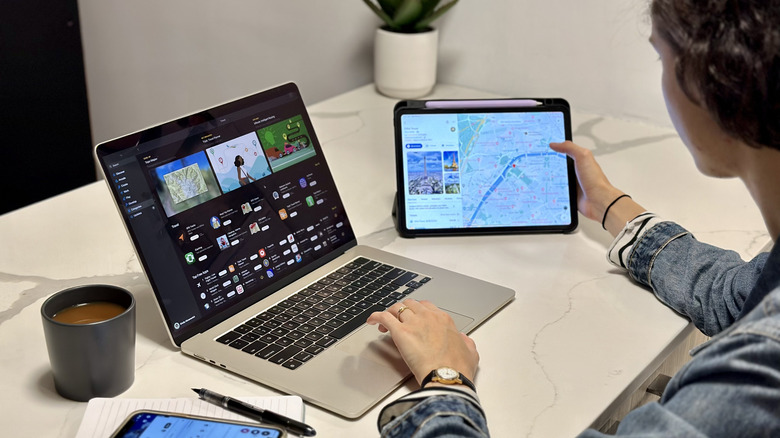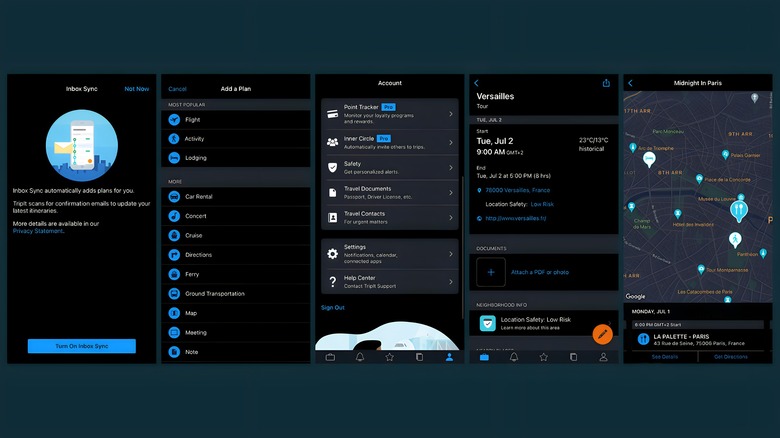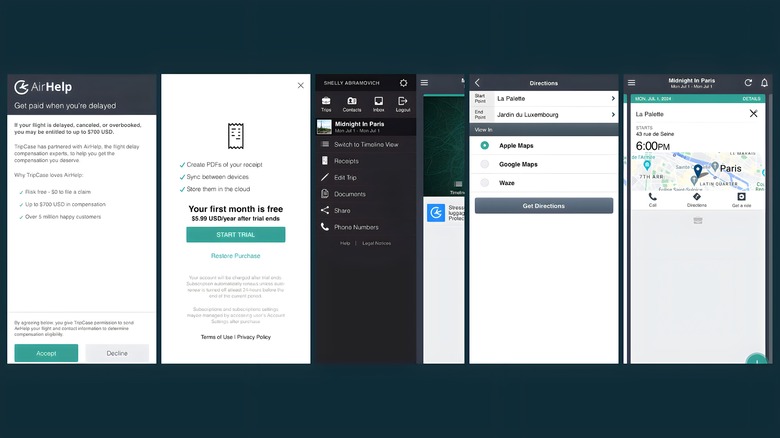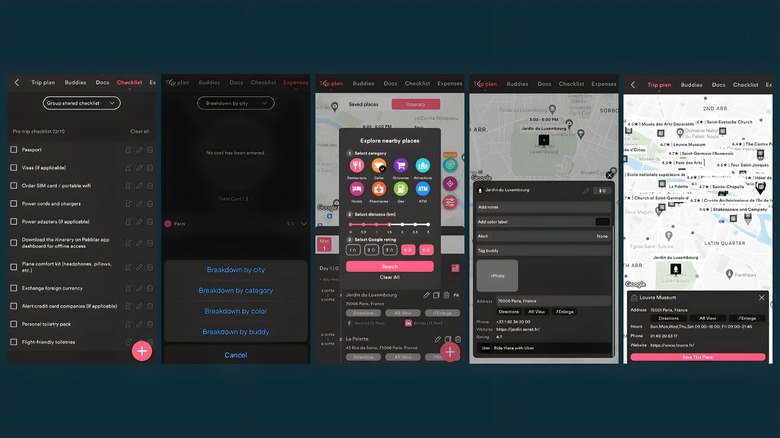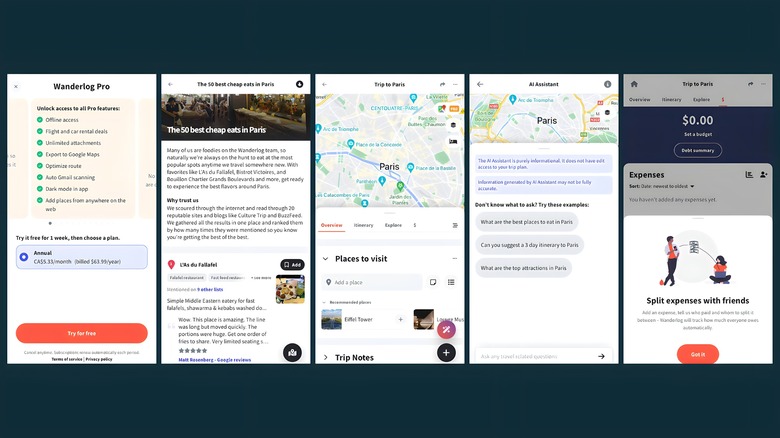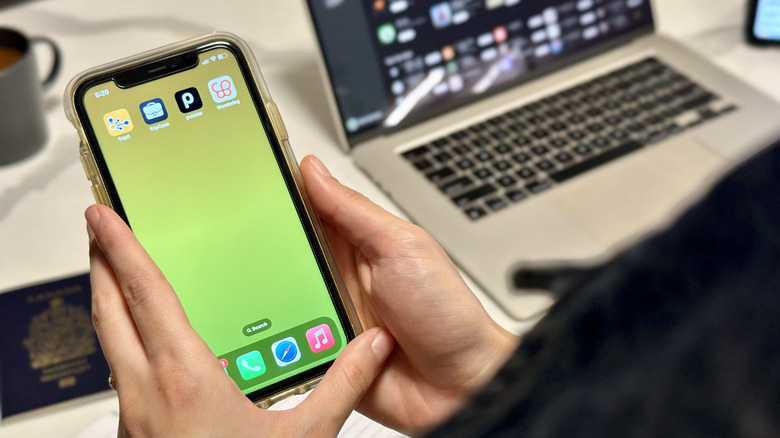We Tried The Most Popular Travel Itinerary Apps, And Here Is Our Favorite
Traveling is the best kind of adventure, but let's face it, the planning bit can sometimes feel like navigating a labyrinth of endless checkpoints. With countless booking confirmations, flight schedules, and activity plans, keeping track of everything can be daunting and borderline impossible, especially if it's all on paper. Enter the world of travel tools and apps designed to be the digital equivalent of a personal travel planner. But with so many options out there, which one is "The One"?
In our quest to find the best travel companion, we dove into the digital sea of travel tools. Drumroll, please, for TripIt, TripCase, Pebblar, and Wanderlog. We tested these four apps for their flashy features, real-world practicality, user-friendliness, overall design, and value. From itinerary creation to real-time updates, we explored the capabilities of these apps to determine which tool can transform chaotic planning into a streamlined experience. Note that these apps are not for booking, reviews, or travel content — you've got Expedia, Tripadvisor, and the rest for that. In this article, we are focusing solely on travel organizational tools.
To equalize the comparison, we'll focus on Paris, a basic multi-day journey to the city of love — for some history, French food, and metropolitan adventure. We'll take you through the ins and outs of each app, share some insights, and ultimately reveal our top pick. So, whether you're a globetrotter planning your next epic voyage or someone looking to organize a hassle-free business trip, join us as we uncover the travel tool that stands a cut above the rest.
TripIt
For our first app, we've chosen TripIt, arguably the longest-running (since 2006) and most popular of the four. It has over 245,000 ratings averaging 4.8 stars on the App Store, with features in Travel+Leisure and Forbes — so we decided to put it to the test. The key feature of TripIt is its ability to automatically create a streamlined master itinerary for every trip using all your travel confirmation emails, from flight bookings to hotel reservations. The app also provides destination-specific information like weather forecasts, local maps, and even medical safety.
While TripIt offers a free version, which is also offline accessible, there is an annual subscription called TripIt Pro for $67.99. This premium version includes additional features such as flight status updates, reward program tracking, and alternative flight suggestions in case of cancellations. The Pro version also has the Inner Circle feature, which allows you to invite others to join your itinerary. Although it's pricier, this elevated version would benefit anyone who is a frequent flier, travels for business, or is taking an elaborate trip with a group.
We found that TripIt worked very well for our Parisian escapade. The map is remarkably useful for seeing the city — the app has a diverse and thorough database of locations, with all the necessary information in the destination's profile. If you need to find a nearby hospital, ATM, or cup of coffee, TripIt has your back. As far as graphics go, the UX is clean, straightforward, and doesn't lag. For the risk-takers and the safe-siders, TripIt has a unique safety feature informing you if a location in your itinerary is above your pre-set personal risk level. It's like having a traveling guardian angel!
TripCase
Not to be confused with TripIt, TripCase is in a league of its own. It seems more popular with the Android crowd, with 19,200 reviews on Google Play averaging 3.9 stars. TripCase allows travelers to manually or automatically consolidate their plans into a single itinerary using booking emails. The app offers real-time flight alerts, itinerary-sharing options, destination information, travel document storage, offline access, and the ability to record trip notes.
The Trip Feed updates travelers with important information and reminders, such as check-in times, gate changes, and weather updates. Another unique feature is the app's affiliation with AirHelp. This claims management company can help you get compensated with up to $700 in the case of a flight delay, cancellation, or overbooking. TripCase has one in-app feature for purchase, a $5.99 annual subscription for Receipts, which saves and syncs all travel receipts. This might be prudent for business travelers, but otherwise, all the travel management capabilities of the app are completely free.
Paris and TripCase got along quite well. We loved that the app is connected with Uber, so we could hail a ride from Jadin du Luxembourg to La Palette to make it in time for a 6 PM dinner. It's also synced with trip tools like Waze and Google Maps for directions, which is perfect. Overall, TripCase's functions are more modest but include all the basics that a travel app should have, and they work well for the most part. The graphics of the app do appear more old-fashioned than the rest in this round-up. But for an app that is 95% free, TripCase will 100% empower your travels.
Pebblar
Pebblar is also a collaborative itinerary planner; however, it stands out as quite unique. A key feature of Pebblar is its map-based planning interface. You can plot all your travel plans on a map, which helps in understanding distances, travel times, and the geographical context of your itinerary. The app can also recommend places to visit based on the destination, user preferences, and even the Google star rating. There's also a feature for tracking expenses, transportation options (including a game-changing Uber feature), offline access, opportunities for collaborative planning, document storage, and a travel checklist in-app.
The main difference between Pebblar and the other apps is that it doesn't automatically sync your confirmation emails to build an itinerary. Everything is done manually. However, it does make travel planning a lot more hands-on and invested, as users build their travel plans by adding flights, accommodations, and activities. Moreover, the app is not entirely free. You receive a 30-day free trial from the moment you register, but once that's done, you either pay $10 per itinerary or sign up for a $9.95 monthly subscription for unlimited itineraries.
We really liked the user-friendly and well-designed interface. The friendly UX and the map view helped with seeing Paris at a glance. The Explore option was outstanding — in a big touristy city, it isn't always wise to trust any old restaurant or cafe, and being able to filter in-app with Google ratings to find the right place is very helpful. Pebblar does hit a long checklist of features and seamlessly integrates them all into a single app. However, the manual input of plans, along with the mandatory subscription, may be a dealbreaker for some travelers.
Wanderlog
Wanderlog is a modern app designed for all types of trips, with a 4.9 rating on the App Store and a 4.7 on Google Play. Wanderlog allows users to plan their journeys by creating a detailed itinerary, and automatically importing all booking reservations from their inbox into their trip plan. One of the standout features of Wanderlog is its collaborative aspect. You can plan trips with friends or family by sharing your journey and allowing others to add or edit plans.
The app has a most exhaustive list of integrated features: expense tracking and splitting, personalized suggestions, checklists, trip notes, offline access, attachment storage, an AI travel planner, and, oh dear, the list goes on. With that said, many of the premium features, like having offline access and being able to integrate your booking emails, are not included in the free version and come at a cost of $63.99 a year. The app's free basic features may be enough for some, but Wanderlog Pro is a big difference. There is also less emphasis on real-time travel updates in Wanderlog compared to the other apps.
Nonetheless, Wanderlog's design deserves a standing ovation, certainly more than any of the other apps. The attractive layout, intuitive UX, and seamless features were truly 10 out of 10. It was genuinely pleasant and easy to plan out a Parisian travel itinerary. And with an AI assistant, Wanderlog feels like a futuristic itinerary planner. Moreover, no other travel app had advice listings like "The 50 best cheap eats in Paris" — sounds like something we do here at Explore!
Which popular travel tool is our favorite?
And now to choose "The One" — no easy feat. Ultimately, picking the right travel app depends on individual needs. Moreover, each app is built differently. Through this process, we've come to the conclusion that for real-time updates and detailed itinerary management, TripIt and TripCase are top choices. For collaborative and visually-oriented planning, look to Wanderlog and Pebblar.
TripIt excels in creating itineraries from booking emails and offers valuable real-time travel updates. However, its more advanced features, including reward program tracking, are locked behind a Pro version. TripCase also provides real-time alerts for flight changes and has a simple, old-fashioned interface, but it's less focused on collaborative planning. Of the two, TripIt stands out for its more advanced and varied features, better UX, and value.
For those prioritizing group travel and map-based planning, Wanderlog emerges as a strong option. Its core features are available for free. However, for more, you'd have to pay. Pebblar is perfect for those who prefer a visual approach to manual itinerary creation. However, after a 30-day trial, its itinerary features require payment. Of the two, Wanderlog stands out for its stunning design, modern and intuitive features, and utility — both on subscription and without.
So, whether you're going to Paris or Panama, and whether you prioritize real-time flight updates, collaborative features, or a visually oriented planning experience, there's a travel app out there for you. Now that we've tried it, perhaps you can try it too!
